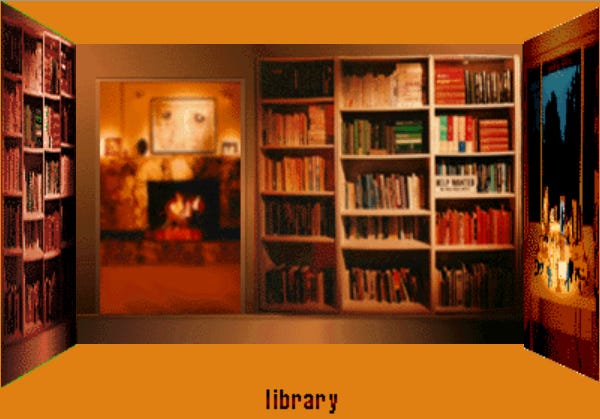Second 'Verse, Same as the First

Two years into the pandemic and the ensuing “work-from-home revolution,” I’m starting to get déjà vu.1 Not because every day in my house is the same, but rather because of all the hype around the so-called “metaverse,” and telepresence, and Web3, and NFTs, and VR/XR/AR. These are new frontiers in digital presence, or so we’re told. Yet it all feels rather familiar, because we heard a lot of it before, back in the 90s.
I just published a book chapter examining the push for telepresence and virtual home spaces in the 1990s, based on a case study concerning Timothy Leary’s first personal website.2 Published in 1996, the site included digitized archival materials and a simulated 3D walk-through of Leary’s real house in Los Angeles. This was right around the time that the 76-year-old Leary teased the idea that he might live-stream his death by euthanasia—just the kind of gonzo digital stunt that some current tech boosters would probably love.

In the chapter, I show that despite the techno-utopian conversations surrounding Leary’s virtual home, it was actually just the a continuation of longstanding negotiations concerning the blurry distinctions between “public” and “private” spaces for reading and writing (the old-fashioned kind, on paper). Today, we have much more complex systems for designing, accessing, and monetizing digital objects, but the fundamental conversations about blurred lines between “home” and “work” haven’t actually changed too much.
You can read the chapter here (and you should feel free to send me an email if you have trouble getting a copy).
This particular project is part of “Reading Home Cultures Through Books,” a collection of essays exploring the relationships between home and reading, edited by Kirsti Salmi-Niklander and Marija Dalbello, out now from Routledge.
In other recent news, there’s a video up now of my recent panel discussion on the intricacies of software emulation as a research method for video game history, hosted by the Australian Centre for the Moving Image and the Play It Again project (click that link for videos of all the other panels as well).
Now while you’re here, I’d like to plug a few upcoming events as well.
I’ll be speaking at the annual Society for Cinema and Media Studies conference later on in March, introducing my current book project. I’m presenting an overview of what I call “post-literary” culture as the link between the psychedelic 60s and cyberdelic 90s. It was supposed to be in Chicago, but now it’s online. Let me know if you’re presenting or attending (or just interested), and we can connect online in some capacity. Is anyone running a Discord for the conference? Let me know.
I’ll be in LA during late May for the annual meeting of the Mellon Society of Fellows in Critical Bibliography. Looking forward to some bibliographic deep-dives! And maybe a little bit of surfing.
SXSW is returning to Austin in a couple weeks. Get in touch if you’re coming to town. Maybe we can meet up, or maybe I can help you find some lodging, or a place to park your car.
As always, let me know if you decide to cite or assign any of my work. Get in touch if you want to propose a book review for Information & Culture, or if you want to chat research. I’m always interested in cool new projects. That’s all for now. Stay tuned for more updates!
It’s always worth repeating: This “revolution” is a deeply unequal one, with those doing the most important work generally the ones least likely to benefit from it. This is as true for underpaid manual labor gigs as it is for the unpaid at-home care work that many remote workers now have to balance.
If you’re not already familiar, Timothy Leary was the “Tune in, turn on, drop out” guy who helped to popularize LSD in the 60s. He spent the 80s and 90s working on computer software, like many other counterculture veterans.

